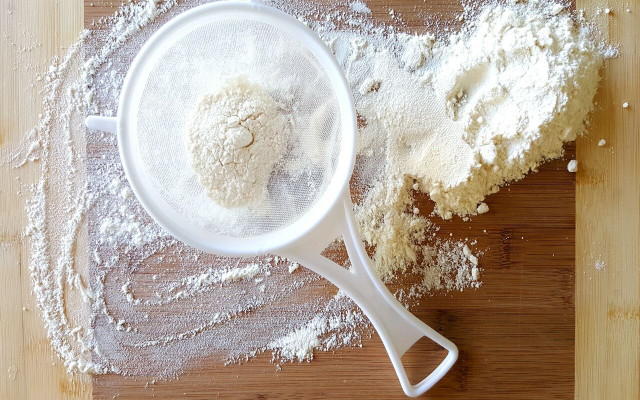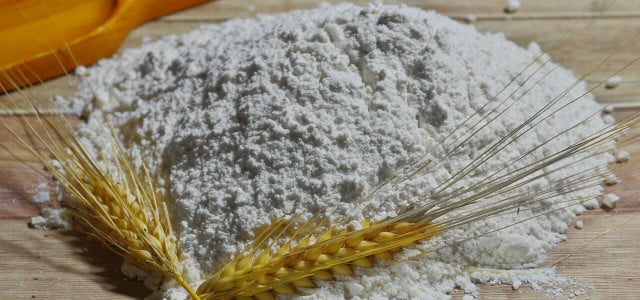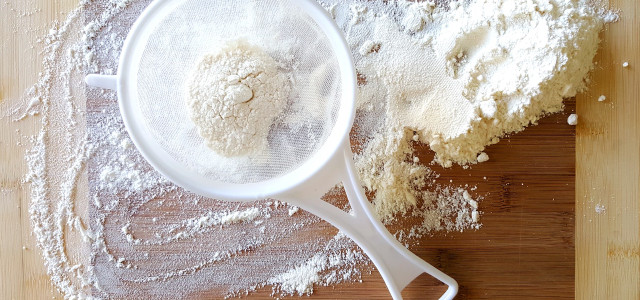It may seem that flour never goes bad, but improper storage can lead to big problems. Learn how to store flour effectively and keep it fresh.
Flour is a baking staple, but that’s not all you can use it for — it’s also great for thickening stews and making sourdough starters! Buying flour in bulk is often much more cost-effective (and creates less packaging waste) than just buying what you need — similar to rice, sugar and dried beans. However, buying in bulk also means you need to know how to store ingredients to keep them fresh. We’ll show you how to store flour to help keep the flour bugs away.
How to Store Flour

(Foto: CC0 Public Domain / Unsplash / Jas Min)
Did you know flour goes bad? Wheat contains oil that can go rancid and cause the flour to go bad, and flour is also susceptible to pests like pantry beetles. Learn how to store flour correctly to avoid having to throw it out.
- Temperature: Flour needs to be stored somewhere cool. The best option is to store flour in the freezer, as it won’t go rancid, and any pests in the flour will be killed off within 4 days. The fridge is also a good spot, but you might not have the space. A cool pantry, cellar, basement or garage can also work.
- Light: Light is the enemy of flour because it generates heat, which causes oxidation. A fridge or freezer is automatically dark, but if storing at room temperature, consider a pantry or stoneware canister.
- Containers: The bag your flour came in is fine for the short-term, but you’ll want to switch it to an airtight container if storing it long-term. Not only will this protect against flour spoilage, but it will also prevent the flour from absorbing odors and protect it from liquids.
Note: Airtight containers, ideally stoneware, glass, or stainless steel, are the best options for storing flour to avoid flour bugs. You may be susceptible if you store flour in the bag it came in. Most pantry beetles enter your home through contaminated food products, so if you do see them, dispose of all affected items immediately and vacuum your pantry out.
How to Store Different Types of Flour



(Foto: CC0 Public Domain / Unsplash / Vlad Kutepov)
There are many different types of flour, and they may require different storage methods. When you can, keep it zero waste by purchasing directly from a zero-waste outlet and packaging it in your own storage containers.
White flour
White flour is the most common and versatile variety, particularly all-purpose flour. You can often purchase this flour in large 20-pound bags at the grocery store. Other types of white flour include pasta flour, bread flour, cake and pastry flour, and self-rising flour.
White flour can be stored for up to three months at room temperature before it should be discarded. White flour can be stored in a colder area, like a cellar, for up to six months. Storing it in the fridge bumps the shelf-life up to one year, and when stored in the freezer, it’ll last for up to two years.
Whole grain flour
Whole grain flour is less refined than white flour and is seen as the healthier option because it keeps the bran and germ along with the endosperm. As a result, it also contains more oils, which can cause the flour to go bad quicker. The shelf-life of whole grain flour at room temperature is only one month, or in a cellar or basement for three months. Storing it in the fridge will extend the shelf-life for six months, and it can last in the freezer for up to one year.
Gluten-free & nut flours
Many gluten-free flours are a mixture of nut, seed, and other grain flours, making them spoil quicker. Nuts go bad due to the oils they contain, and the same is true when they’re ground down into flour. Err on the side of caution when storing these types of flour, and stick to the guidelines mentioned above in the whole grain section. If it looks or smells “off”, it probably is.
Coconut flour
Coconut flour has a similar shelf-life to white flour and can be stored for up to two years in the freezer. Coconut flour should be used with other flours due to its high absorbency and high fiber content.
Rice flour
Like coconut flour, rice flour is a common substitute for all-purpose flour. It’s high in fiber and naturally gluten-free. Rice flour is most commonly used to make noodles, but it can also be used to make pastries and cakes. You can store it in the pantry for three months, in the fridge for eight months, and in the freezer for up to one year.
Has Your Flour Gone Bad?



(Foto: CC0 Public Domain / Unsplash / Ksenia Chernaya)
When it comes to telling if any food has gone bad, trust your instincts. Flour that’s gone bad might smell a bit off, so do the sniff test. If you feel something isn’t right, or see pests or mold, discard the flour immediately.
If you bake with flour that’s gone bad, you don’t need to panic — it’s unlikely you will be harmed. The recipe just won’t taste as good as it would if you were using fresh flour. However, if mold is present, there is the risk of ingesting mycotoxins, which may cause vomiting or diarrhea.
Read more:
- Toasted Flour: 5 Reasons To Try It & How To
- Healthy Grocery List: 6 Unhealthy Foods to Cross Out
- How to Keep Your Produce Fresher for Longer
Do you like this post?








